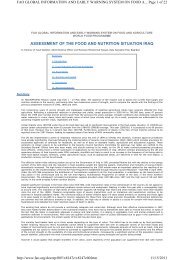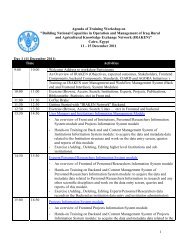Vermiculture in Egypt: - FAO - Regional Office for the Near East and
Vermiculture in Egypt: - FAO - Regional Office for the Near East and
Vermiculture in Egypt: - FAO - Regional Office for the Near East and
Create successful ePaper yourself
Turn your PDF publications into a flip-book with our unique Google optimized e-Paper software.
which humic acids could affect plant growth. There is a fur<strong>the</strong>r alternative explanation<br />
<strong>for</strong> <strong>the</strong> hormone-like mode of action of humic acids <strong>in</strong> <strong>the</strong>se experiments. In our<br />
laboratory, we have extracted plant growth regulators such as <strong>in</strong>dole acetic acid,<br />
gibberell<strong>in</strong>s <strong>and</strong> cytok<strong>in</strong><strong>in</strong>s from vermicomposts <strong>in</strong> aqueous solution <strong>and</strong><br />
demonstrated that <strong>the</strong>se can have significant effects on plant growth. Such substances<br />
may be relatively transient <strong>in</strong> soils. However, <strong>the</strong>re seems a strong possibility that<br />
such plant growth regulators which are relatively transient may become adsorbed on<br />
to humates <strong>and</strong> act <strong>in</strong> conjunction with <strong>the</strong>m to <strong>in</strong>fluence plant growth (Atiyeh et al.,<br />
2002).<br />
Vermicompost has been promoted as a viable alternative conta<strong>in</strong>er media component<br />
<strong>for</strong> <strong>the</strong> horticulture <strong>in</strong>dustry. The addition of vermicompost <strong>in</strong> media mixes of 10%<br />
<strong>and</strong> 20% volume had positive effects on plant growth. The greatest growth<br />
enhancement was on seedl<strong>in</strong>gs dur<strong>in</strong>g <strong>the</strong> plug stage of <strong>the</strong> bedd<strong>in</strong>g plant crop cycle.<br />
Growth <strong>in</strong>creases up to 40% were observed <strong>in</strong> dry shoot tissue <strong>and</strong> leaf area of<br />
marigold, tomato <strong>and</strong> green pepper. The <strong>in</strong>creased vigor exhibited was also<br />
ma<strong>in</strong>ta<strong>in</strong>ed when <strong>the</strong> seedl<strong>in</strong>g plugs were transplanted <strong>in</strong>to larger conta<strong>in</strong>ers with<br />
st<strong>and</strong>ard commercial pott<strong>in</strong>g substrates without vermicompost. Additionally, <strong>the</strong>re<br />
were benefits apparently result<strong>in</strong>g from <strong>the</strong> nutritional content of <strong>the</strong> vermicompost.<br />
All of <strong>the</strong> plugs were produced without <strong>the</strong> <strong>in</strong>put of additional fertilization. The<br />
potential exists <strong>for</strong> growers to use vermicompost-amended commercial pott<strong>in</strong>g<br />
substrates dur<strong>in</strong>g <strong>the</strong> plug production stage without <strong>the</strong> use of additional fertilizer<br />
(Bachman <strong>and</strong> Metzger, 2008).<br />
5.4. Potentiality of vermicompost as a source of fertilizer <strong>in</strong> <strong>Egypt</strong><br />
Consider<strong>in</strong>g urban wastes as mentioned <strong>in</strong> <strong>the</strong> previous chapter <strong>for</strong> <strong>the</strong> year 2005<br />
ranged from 15 to 16 million tons, compostable matter <strong>in</strong> <strong>the</strong> wastes as 50-60% <strong>and</strong><br />
average collection efficiency as 70%. <strong>Egypt</strong> has an estimated potential of produc<strong>in</strong>g<br />
from urban wastes about 1.99 million tons of compost each year conta<strong>in</strong><strong>in</strong>g about<br />
21,000 ton N, 5,000 ton P, <strong>and</strong> 10,640 ton K (Table 5.2). Inappropriate solid waste<br />
management <strong>and</strong> production of poor quality of composts are ma<strong>in</strong> constra<strong>in</strong>t <strong>in</strong><br />
exploit<strong>in</strong>g such large amount plant nutrients <strong>for</strong> <strong>in</strong>creas<strong>in</strong>g crop productivity.<br />
On <strong>the</strong> o<strong>the</strong>r h<strong>and</strong>, agricultural wastes <strong>in</strong> <strong>Egypt</strong> could produce almost four times<br />
compost material compared to urban wastes, assum<strong>in</strong>g that 100% of it is organic<br />
material <strong>and</strong> all of it is accessible to <strong>the</strong> grower. There are o<strong>the</strong>r advantages of this<br />
waste, which are <strong>the</strong> availability of space <strong>and</strong> directly l<strong>in</strong>ked to <strong>the</strong> farm. This<br />
m<strong>in</strong>imizes <strong>the</strong> need of collection <strong>and</strong> transportation. The amounts of N, P <strong>and</strong> K that<br />
could be produced from agricultural wastes are almost four folds of that of <strong>the</strong> urban<br />
wastes.<br />
From both sources, <strong>the</strong> total composted material is almost 10 million tons, conta<strong>in</strong><strong>in</strong>g<br />
about 10 thous<strong>and</strong> tons of nitrogen, 20 thous<strong>and</strong> tons of phosphorus, <strong>and</strong> 41 thous<strong>and</strong><br />
tons of potassium. Nitrogen fertilizer obta<strong>in</strong>ed from organic wastes could save up to<br />
5.9% of that consumed <strong>in</strong> 2008; while more than 10% of phosphorus fertilizers<br />
consumed <strong>in</strong> 2008 could be saved.<br />
51





